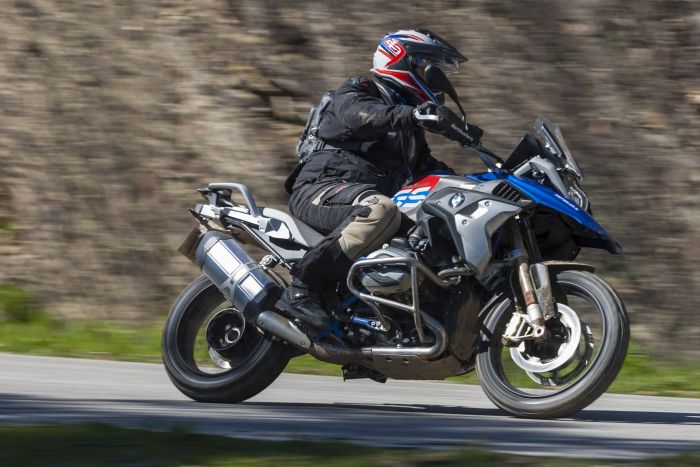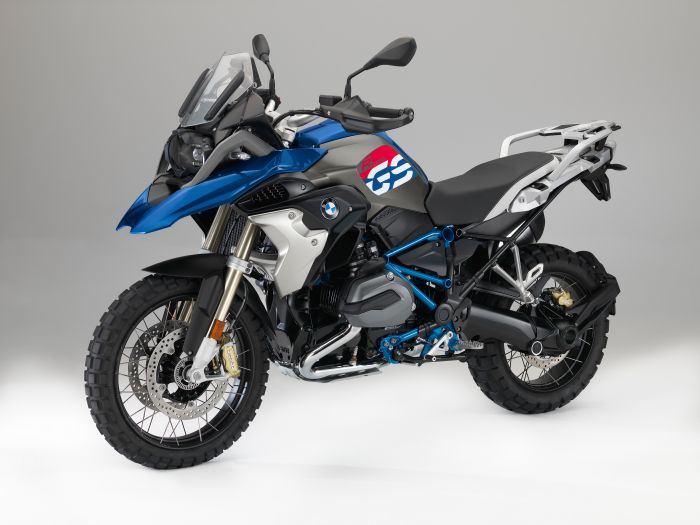At the tail end of 2016, it was announced that the BMW R1200GS and GS Adventure had, once again, claimed the titles of the top two selling bikes in the UK over 125cc. Though last year was the first time since the bike’s creation that the GSA overtook the standard model in sales. It was also at the end of 2016 that news broke from EICMA, the huge motorcycle trade show in Milan, that BMW had introduced two new models into the GS family – the BMW R1200GS Rallye and the Exclusive (OK, three if you count the 310GS which was launched in August 2017 – you can read our review on that bike here).
While the Exclusive is a slightly updated version of the standard GS, featuring Euro 4 compliance, refined ESA and DTC, new colours and a few cosmetic tweaks, the BMW R1200GS Rallye branches off a little. It’s still largely based on the standard model, but it’s been tinkered with to make it more off-road focused straight out of the showroom.
BMW billed the Rallye as “the sportiest series production GS of all time”, with the bike playing host to a medley of additional accessories and components. This version of the GS sees a one-piece seat fitted as standard, a smaller sports windshield, plastic radiator and frame guards, wider enduro-style footpegs, and cross-spoke wheels – at a price of £12,730, just £480 more than the standard GS.
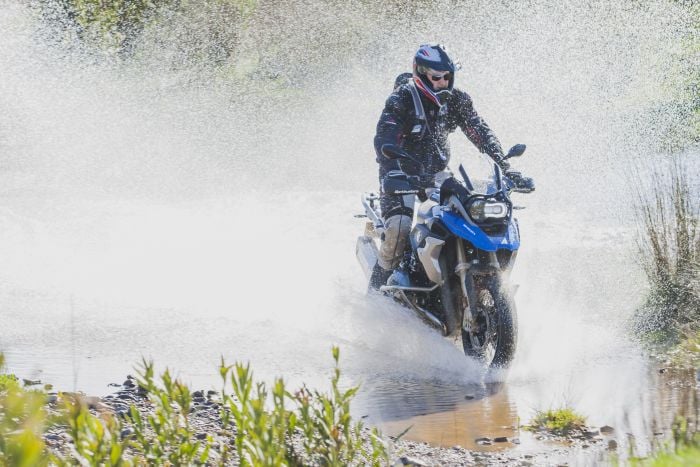
For an extra £290 you can add sport suspension, which firms up the ride and raises the forks by 20mm (making it the same as the GSA), while you can also add sturdier crash bars (£323) and a Dynamic Package, which adds LED headlights, Gear Shift Assist Pro and LED indicators, for an extra £1,490.
Finally, for the cost of £14,625, there’s the Rallye Sport, which adds an off-road riding mode and more sophisticated traction control on top of what you get with the Dynamic package. Finally finally, you can add Dynamic ESA, which automatically adjusts the shock preload as you go, which brings the price up to £15,775, and all of a sudden, as if by magic, we’re in the GSA price range. Phew.
It was the launch of the Rallye Sport that had lured me to Portugal, though the bike I was to be riding was beefed up with the optional metal engine bars and aluminium bash plate. My evening on the launch began after checking into our hotel in Vilamoura, when I came down to the bar area for a drink. There, parked up in all of their magnificent glory were two BMW R1200GS Rallyes.
While the other chaps on the launch checked out the intricate details of the bike, I stood and stared, my mouth gaping and drool running down my chin. I looked on with an adulation that I haven’t felt since I first laid my eyes on the pixelated but incredibly sexualised Lara Croft, in my Tombraider game some 20 years ago.
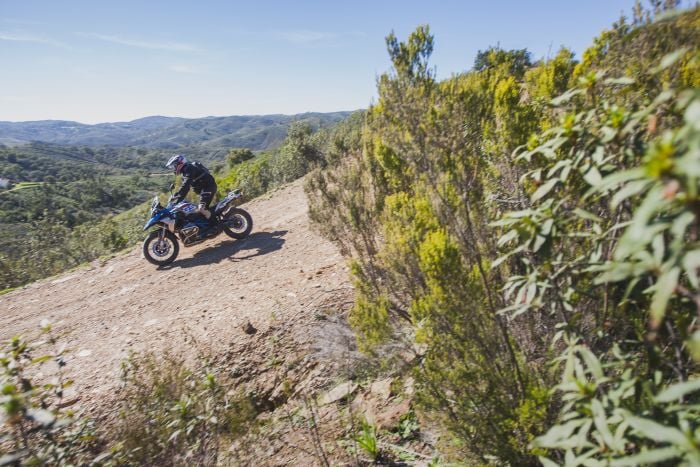
The standard GS splits opinions when it comes to looks, with one school loving the brashness of it and the other calling it downright ugly, but the Rallye is a thing of beauty. A new colour scheme has been introduced and that, coupled with the minor, more off-road ready adjustments to the setup, has made this bike an absolute stunner.
Think of the standard BMW GS as Sandy from Grease pre-You’re The One That I Want, and the Rallye as the gorgeous, tarted up blonde bombshell that drives into the clouds with Danny Zuko as the end credits role.
And let’s be honest, you can preach the benefits of a good MPG, seating position, engine or whatever else you want to me as much as you please, but if a bike doesn’t look good, I’m probably not going to fork out my hard-earned cash for it.
The next day promised to be a feature-packed event, with us riding a 120-mile route from morning to evening along the Algarve’s enviable network of off-road trails and twisty roads. After gearing up and being briefed by Simon Pavey, the legendary 10-time Dakar entrant who runs the BMW Motorrad off-road training facility in Wales, I threw a leg over the saddle of my BMW R1200GS Rallye.
With a seat height of 860mm (which is raised to 890mm with the Sports Suspension), I found myself being able to firmly place my feet on the ground (I stand at 6’2), though a shorter legged member of the group, who measured in at 5’6 struggled – so he decided to take the low suspension version, which offers a seat height of a manageable 800mm.
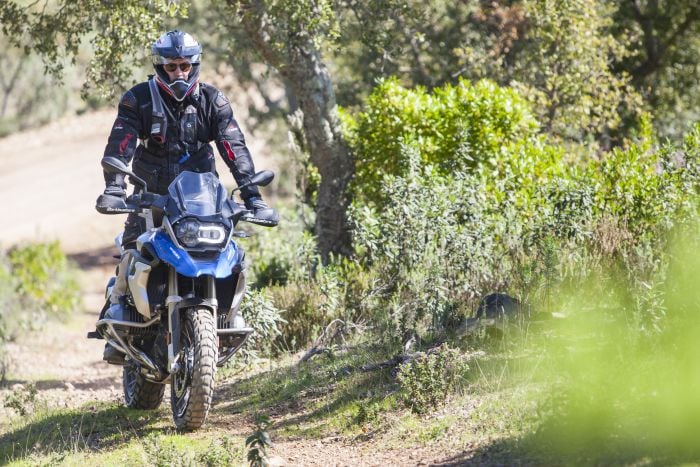
Not much has changed once you’re in your perch, with the Rallye having the same comfortable seating position and arse, feet, hands triangle as the standard GS, though you’ll instantly notice the stumpy ‘sports’ screen in front of you.
The bench seat doesn’t quite offer the comfort of the stock GS, but its presence is appreciated as soon as you touch the dirt, allowing you to shift your weight along the bike with more freedom, while the narrower profile makes it easier to stand up and control the bike when on the pegs. It also offers the benefit of making the 860mm seat height slightly more manageable, as it’s easier to put a foot down and paddle.
Our bikes were fitted with Karoo 3 tyres, though more road biased rubber is an option when you purchase. As we were going to be spending most of our time on the trails, they were most welcome, and performed great on the short road ride on tarmac to our first section of off-road. The Karoo 3s and the BM’s on-road credentials would be put to the test later in a more demanding blast along the rollercoaster-like roads of the Algarve.
As we explored the dirt tracks the bike impressed, though I found myself wondering just how much of it was down to the Rallye’s additions. The standard GS is a mighty fine off-roader in itself (I’m talking about easy gravel trails here), and I’m not being harsh when I say that the Rallye’s additions don’t really add anything revolutionary, though they are worthwhile off the tarmac.
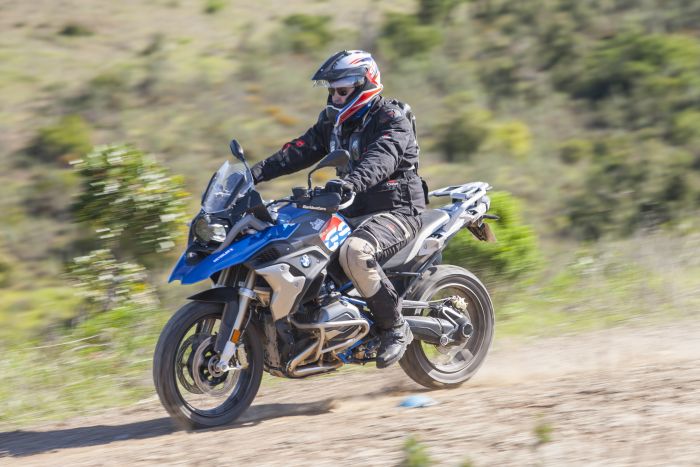
Wider pegs allow you to get a better and more controlled feel for the machine, and the smaller screen is better optimised for off-road riding, giving you an unrestricted view of the trail ahead, and not smacking you on the face when you jolt forward. These, however, are both accessories that you can add to your standard GS (along with the one-piece seat) if you have the inclination.
The torquey engine allows you to cruise along fire tracks and easy gravel trails in third, taking bends without having to think about changing gear, and when you come to more technical, slower sections, it pulls you along, up and over obstacles with less chance of the back wheel spinning up.
As has always been the case with the GS, the fantastic design and weight distribution makes you feel like you’re riding a much lighter bike than the 250kg you are sat on. The inclusion of Gear Shift Pro as standard is also welcome, allowing you to shift up and down the gears without pulling in the clutch. BM has really excelled here, as the gear changes are silky smooth throughout.
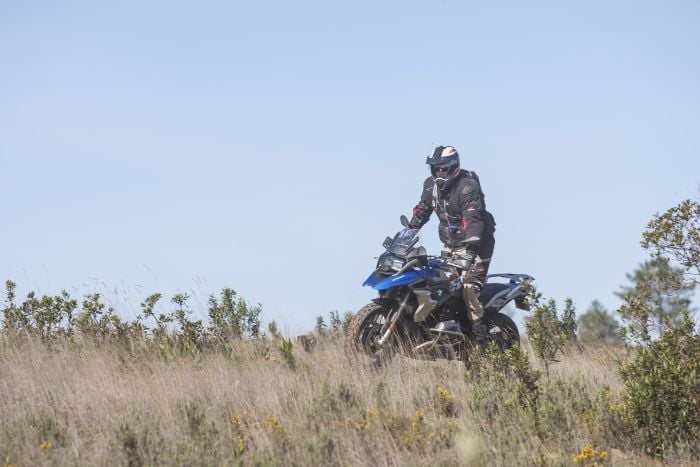
I would have liked to have seen the difference the increased suspension travel would have made to the bike, though in truth the standard kit that we had was more than adequate for the terrain we were riding (which is probably the limit of where most GS Rallyes will be taken by their owners).
The new ESA also seems like a worthwhile addition, automatically adjusting the preload to suit the weight on the bike, and the riding mode you’re in. On previous models of the GS you would set this by flicking between one rider, rider plus pillion, one rider plus luggage, and so on, but the new ESA works all of this out for you.
The BMW R1200GS Rallye comes with ABS as standard, as all new bikes must thanks to Euro 4, but this, along with traction control, is simply turned off and on with the press of a button (as is found on stock GSs). I still think, in this regard, the Africa Twin’s method for changing the level of traction control, along with the incremental levels it offers, is the best in the game, but the GS is no slump either.
Switching the bike into Enduro mode alters throttle response, traction control, suspension and ABS, with the aides allowing you to be a bit more ballsy with your riding. The off-road ABS works supremely well, allowing you to grab or stomp the breaks and remain upright, while the DTC is wonderful, giving you just enough leeway to initiate a back wheel slide before kicking in and saving you from embarrassment.
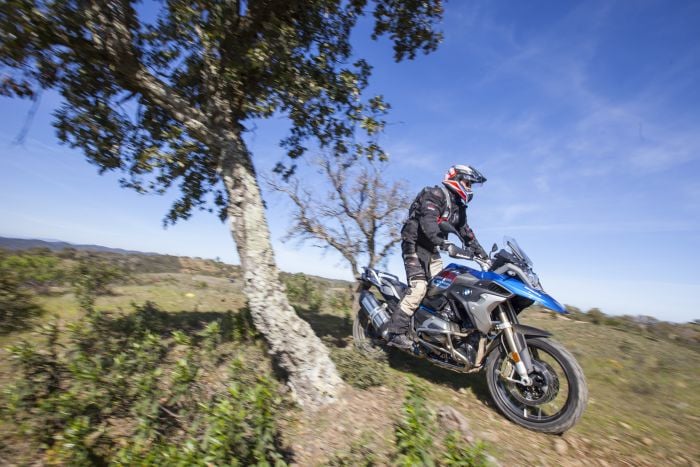
Also available as a no-cost extra is the Eundro Pro plug, which can be plugged in under the seat. Like a cheat code in a computer game, this unlocks Enduro Pro and Dynamic Pro riding modes, which allow you to dial in the different power modes and then set the ABS, traction control and throttle response through a separate menu – a great addition.
In this respect, the BMW R1200GS Rallye allows even average off-roaders to ride with more confidence, and thanks to the narrower seat, smaller screen, and redesigned front end (which has been tucked in slightly), it’s not quite as intimidating as the stock model. Something that I experienced once again, along with 160 others at this year’s GS Trophy in Wales where they bike was thrown around a variety of technical courses and came out on top.
After a few hours of playing on the trails we were let loose on some of the twistiest roads I have ever laid eyes on. From memory, there can’t have been a straight section of tarmac longer than 100m, and this gave me chance to really try out the bike’s, and the Karro 3’s, performance on road, and boy was it fun!
For such a big, heavy bike it’s amazingly nimble, and the rider aides allow you to ride at speeds that you probably shouldn’t. The GS isn’t the pokiest of adventure bikes, with the KTM 1090 offering a far more ferocious rate of acceleration, but the 125bhp engine is more than capable of offering you an exciting ride around alpine-style twists and turns. Push it too hard, and the rider aides kick in, with the traction control flashing orange to keep you on course and upright.
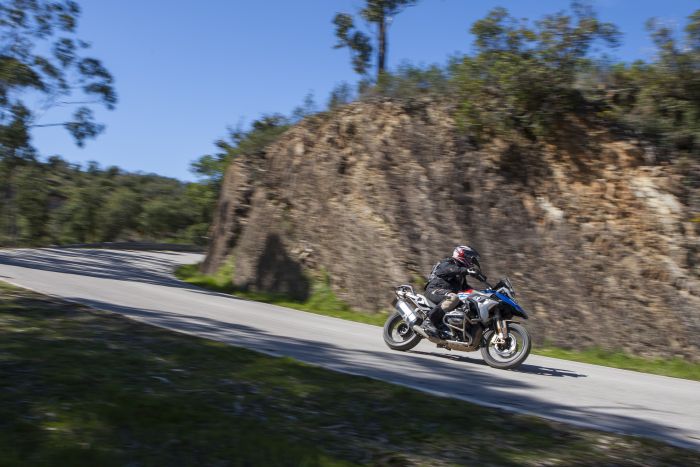
This enthusiastic assault on the tarmac gave the chance for the Karoo 3s to argue their case as a genuine all-purpose tyre, and I was amazed at the amount of grip and control they provided when snaking through the Portuguese hills. If you’re more likely to be staying on tarmac, however, road tyres are available as standard as well.
There’s no denying that the BMW R1200GS Rallye is an extraordinary machine. It makes off-roading on a big adventure bike accessible to many in terms of technical skill, and it’s a blast to ride, but the question for me still remains: are you really going to want to spend £13,000 (in excess of £15,000 if you add on the extras) on a bike that you’re going to throw around trails and off-road courses? Probably not, but it’s the image of being able to do that that the GS brand has built its success on.
It provides you with the means of conquering the trails, and a presence that tells others that that’s exactly what you’re going to do, much like the SUVs that are growing in popularity in the UK.
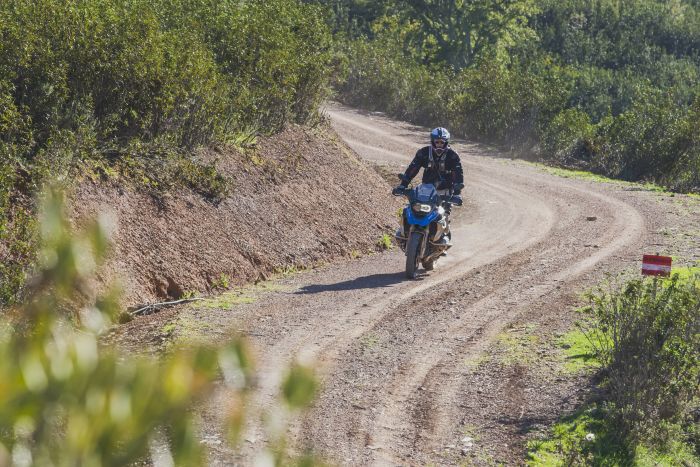
The sensible rider in me would opt for the Sport package, which offers the prestige and image of the bad to the bones standard BMW R1200GS Rallye, but with the perks and creature comforts (larger screen, more comfortable seat) of the base GS. But the emotional side of me would say screw it and go all out with the off-road extras, and after all, motorcycling is an emotionally driven hobby.
Conclusion
The BMW R1200GS Rallye builds on the already excellent GS to make it a big adventure bike with improved off-road credentials. Engine updates for 2017 make for a smooth, refined ride, and the new colourway adds an air of sex appeal to the bike that’s bound to attract the attention of many.
>>> Related: BMW R1200GS Adventure 2018 review
ABR BMW R1200GS Rallye Verdict
As a commuter
I don’t see any reason why I wouldn’t commute to work on the BMW R1200GS Rallye. If you’re fighting your way through the city centre of London you might want something a bit smaller, but for most commutes it’ll get you there and back in comfort – and you might feel tempted to head down a green lane on your way home.
As a weekend tourer
Out of the GS models available, it’s the least suited, but in reality, it’s more than up to the job. It’s a great option if your weekends away involve a spot of green laning, but if your route has lots of motorway miles you’ll want a bigger screen.
As an off-roader
Honestly, the BMW R1200GS Rallye is excellent off-road. The big boxer engine can be an issue when navigating through tight ruts, but for gentle lanes and fire tracks it’s superb. It rides like it’s lighter than it is and it inspires confidence, with all of the rider aids you need to make you seem like a pro. Of course, at 244kg, if you drop it you might need to call in a crane to help you pick it up.
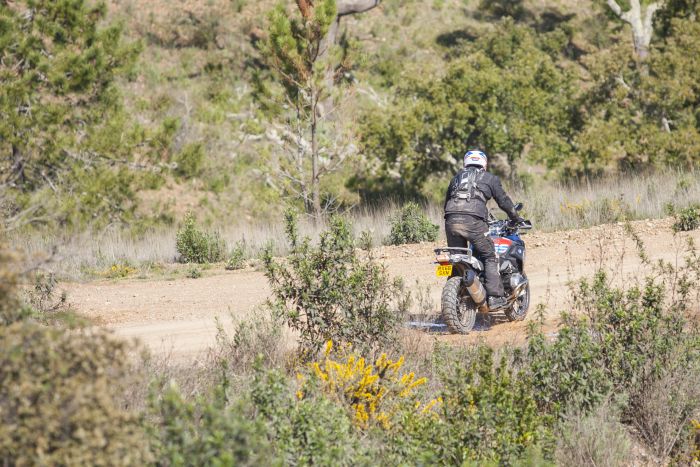
As a continental road tourer
It wouldn’t be my first choice, but again, I’d be happy to head over to the Alps on it. Full luggage kits are available and if you change the screen to help on the long motorway blasts you’ll be good.
The more off-road focused seat isn’t quite as comfortable as that found on the standard GS, but I had no problems after a full day in the saddle. Once you’ve made it to your destination and you’re exploring the twists and turns of the Alps, it handles surprisingly well on the tight hairpins and feels a lot lighter than it is.
As a RTW overlander
Ewan and Charley, amongst many others, have proven that the GS can go around the world, the BMW R1200GS Rallye just means that you’ll be able to take a more adventurous route.
As a pillion carrier
While you can fit a pillion on the bench seat, it’s not going to be the most comfortable by any means. Switch this up for the standard two-tier seat, however, and your passenger will be enjoying the ride just as much as you will.
BMW R1200GS Rallye specs
Price: £12,730 (basic model)
Engine: 1170cc, air/liquid-cooled flat twin
Power: 123bhp (91kw) @ 7,750rpm
Torque: 92lb-ft @ 6,500rpm
Gearbox: Six-speed, shaft final drive
Suspension: Front; 190mm travel Telelever, non-adjustable. Rear; 200mm travel single shock, adjustable
Brakes: Front; 2x305mm discs, four-piston radially mounted calipers. Rear; Single 276mm disc, two-piston caliper
Tyres: Front; 120/70 19”, Rear; 170/60 17”
Seat Height: 860mm (890mm with sports suspension or 800mm when low seat option is purchased)
Weight: 244kg (kerb)
Fuel capacity: 20-litres
More info: www.bmw-motorrad.co.uk

